Which processor is best for gaming?
CPU, aka CPU- the heart of any computer. Performance and power largely depend on it, which is important for gaming systems. AMD, which is engaged in a heated battle for gamers’ wallets with video card manufacturer NVIDIA, is trying to defend its position in the processor segment, competing with Intel.
The question is which processors are best for gaming, Intel or AMD, has been worrying the gaming community for many years. Both companies are giants in the production of processors, but in terms of processing power, Intel has an advantage over AMD. Occupying about 85% of the processor market, Intel has almost limitless possibilities for development and production. The same cannot be said about AMD.
In many previous articles, company specialists “ AboutComputers"they said that the market computer games is growing at a rapid pace, and all new games are placing ever higher demands on gaming hardware. Recent blockbusters such as Bioshock Infinite, Crysis 3 or TombRaider, require a powerful and fast processor.
Where to choose?
To conduct comparison tests between two processors, it is important to use the same conditions. Same volume random access memory, similar characteristics motherboard and other computer components. This is the only way to check the superiority of one processor over another. Various tests carried out by specialists ProComputers store, show that Intel processors Most of them are more productive than similar models from AMD.
Below are several options for the most preferred processor models for gaming. Prices are constantly changing, so prices are approximate.
Minimum standard for a gaming computer
The best processor at a price of 3000 rubles - Intel Pentium G2120 (Ivy Bridge)
The best processor at a price of 4200 rubles - Intel Core i3-3220 (Ivy Bridge)
Of the new dual-core processors of the Core i3 family, the model that is of greatest interest is Core i3-3220, which can be used for . This processor replaced the model Core i3-2120 previous generation Sandy Bridge. The new product features reduced energy consumption and heating. And thanks to Hyper-Threading technology, two physical processor cores easily turn into four logical cores.
The best processor at a price of 4800 rubles- Intel Core i3-3225 (Ivy Bridge)
The new Intel Core i3-3225 processor has earned the title of “people's” processor, combining affordable prices with ample capabilities. It differs from the Core i3-3220 model presented above by a more powerful integrated HD4000 video chip. If the computer will work for some time without a video card (for example, until the next salary) or as a media center, then the IntelCore i3-3225 option is very attractive.
The optimal bracket for a gaming computer
The best processor at a price of 5,800 rubles- Intel Core i5-2310 (Sandy Bridge)
CPU Intel Core i5-2310 It is equipped with four cores based on Sandy Bridge architecture and provides excellent performance per core, but its overclocking is limited. For overclocking, we recommend versions of “K” processors with an unlocked multiplier. For example, Core i5-2550K.
The best processor at a price of 7,000 rubles- Intel Core i5-3570 (Ivy Bridge)
CPU Intel Core i5-3570 is the most inexpensive model based on the current Ivy Bridge architecture, supporting overclocking using a multiplier. But its standard frequency of 3.4 GHz is also quite decent. This is a great processor for gaming.
Article " Which processor is better for gaming?" is written for gamers who want to get the most out of their money's worth. But even if you're not a gamer, these processors are smart options for multimedia home computers. ProComputers store they will collect for you Personal Computer based on any of the listed and many other processors at the most low prices. And if you hurry, you will also receive free shipping.
People continue, with persistence worthy of better use, to inflate a significant part of their budget on the processor, and in the meantime, the dollar exchange rate has increased significantly and left its mark on the final picture. Today, at such prices, you have to save money and assemble the most budget configurations, and not the computer of your dreams. In this article we will look at a new product Intel, which belongs to the Core i3 family, and we’ll try to find out whether such a processor is suitable for a wide range of tasks, including a simple gaming configuration.
Packaging and equipment
The packaging and delivery set are classic; in the BOX version you will find a cooler, a sticker and documentation, and when purchasing an OEM, in the best case, the processor will be equipped with an antistatic bag. I recommend it to everyone visual inspection When purchasing even the boxed version, no one is immune from defects. For example, quite recently, when purchasing a computer configuration, we came across a processor without a pair of capacitors on the reverse side. Of course, this was discovered during the acquisition process, but if you are inattentive, then it will be too late and you will need any specialist service center will say that you damaged the processor.
If the price for the BOX version differs slightly, around 100-300 rubles, then I advise you to take it, as you will receive an extended warranty for three years and additionally save on the purchase of the cooler.
Specifications
✔
Socket: LGA1150
✔
Family: Core i3
✔
Model: 4160
✔
Core: Haswell
✔
Number of cores: 2
✔
Process technology: 22 nm
✔
Clock frequency: 3600 MHz
✔
Hyper Threading support: yes
✔
L1 cache size: 2 x 64 KB
✔
L2 cache size: 2 x 256 KB
✔
L3 cache size: 3072 KB
✔
Integrated Graphics: HD Graphics 4400, 1150 MHz
✔
Heat dissipation: 54 W
✔
Technology support: Intel Virtualization Technology, Enhanced Intel Speedstep Technology, SSE4.2, Enhanced Virus Protection.
Test bench configuration
Processor: Intel Core i3-4160 (3600 MHz)
Motherboard: ASUS SABERTOOTH Z97 MARK 1
Cooler: Corsair H110
Thermal interface: Arctic Cooling MX2
Memory: Crucial Ballistix Tactical Tracer (2 x 4 GB DDR3 1866 MHz)
Video card: Gainward GTX 970 Phantom
SSD storage: SSAMSUNG 840 Pro (MZ-7PD256BW) 256 GB
Power supply: Corsair AX860, 860 Watt
Case: NZXT Switch 810
Monitor: VIEWSONIC VP2770
operating system: Windows 7 64-bit Service Pack 1
Video driver version: Nvidia 344.75
The basis is a platform on the LGA1150 socket based on the motherboard ASUS board SABERTOOTH Z97 MARK 1. Thin layers of Arctic Cooling MX2 were applied as a thermal interface. The XMP profile was activated for the RAM, the final settings were: frequency 1866 MHz, timings 9-9-9-27, everything worked fine during the entire testing. The Corsair H110 is clearly overkill for this model and was used for the sake of ease of assembly.
Preparing for testing
For correct recognition and operation Intel processor Core i3-4160 required updating the motherboard BIOS to latest version 1202. Then it was necessary to go into the BIOS and adjust everything necessary settings, including for RAM.
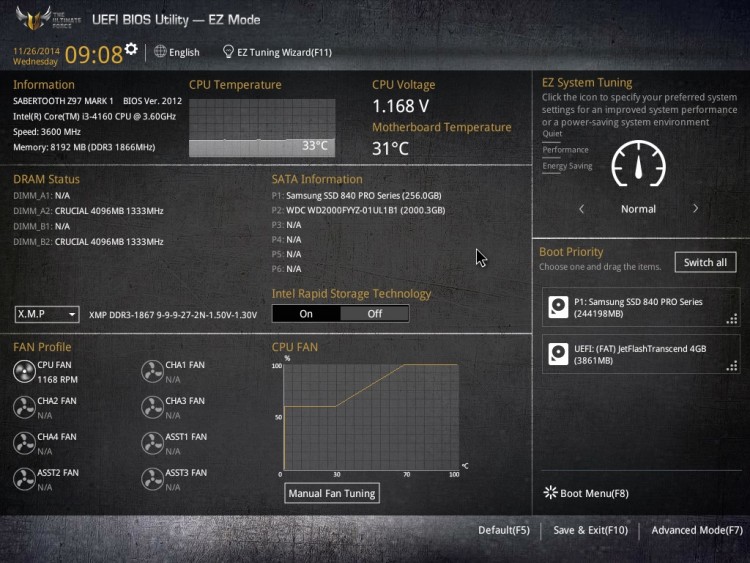
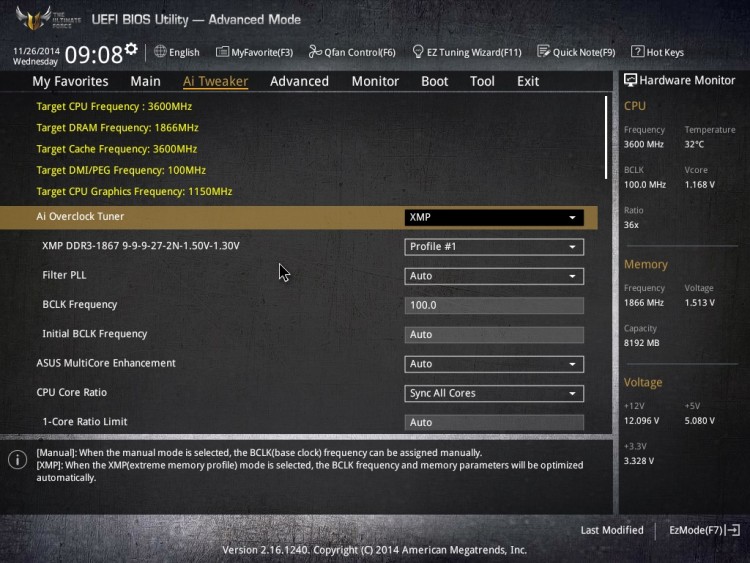
The Intel Core i3-4160 processor is a dual-core processor with Hyper support Threading, which allows it to keep the performance rating closer to 4-core models. This processor equipped with an integrated graphics core HD Graphics 4400, the maximum dynamic frequency of which can reach 1150 MHz. The integrated graphics uses part of the system memory. The main function of the built-in GPU is the ability to upgrade the video card without losing the functionality of the PC at the time of its absence. In addition, this solution is also useful for office PCs.

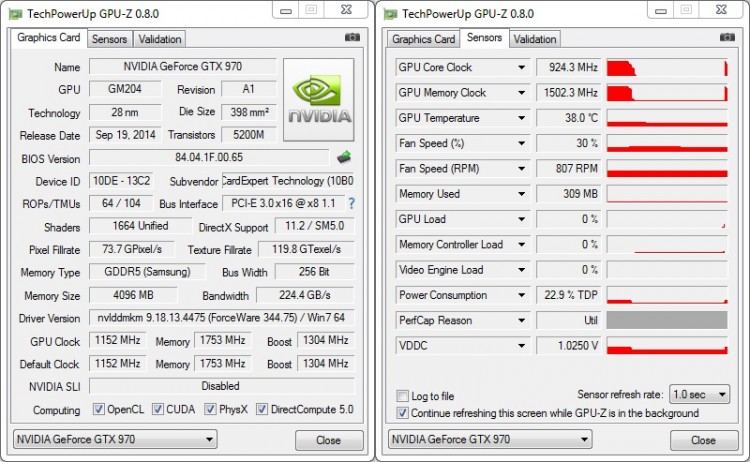
As can be seen from the LinX results, the processor temperature at maximum load did not exceed 59 degrees, while the two fans on the Corsair H110 radiator rotated at minimum speed.

Testing in synthetics
Processors of this kind only partially satisfy the requirements of specialized applications; in particular, Hyper Threading will benefit from the possibility of multi-threaded software operation.
AIDA 64 cache and memory test - evaluates the bandwidth of read/write/copy operations, and also conducts a memory latency test.

Fritz Chess Benchmark is a test that determines processor performance based on chess algorithms. As you can see, 4 streams are recognized, which gives an increase in speed in this application.

WinRAR is one of the most common operating scenarios home computer The results are shown indicating the current speed when processing with a single core and in multi-threaded mode; the difference in speed is clearly demonstrated here.

x264 FHD Benchmark perfectly emulates the video encoding process for a fixed frame value. The less time was spent, the better.
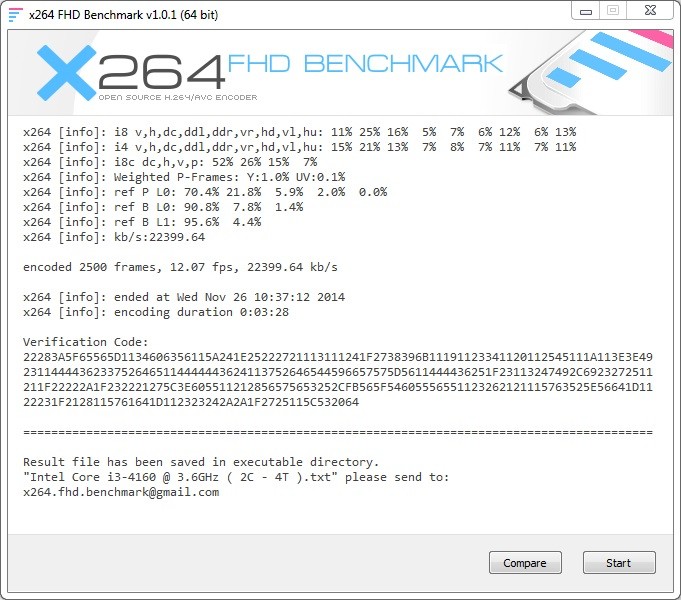
CINEBENCH - This test is useful for assessing the speed of 3D rendering. Divided into two parts, the first evaluates the processor, and the second the performance of the graphics accelerator.
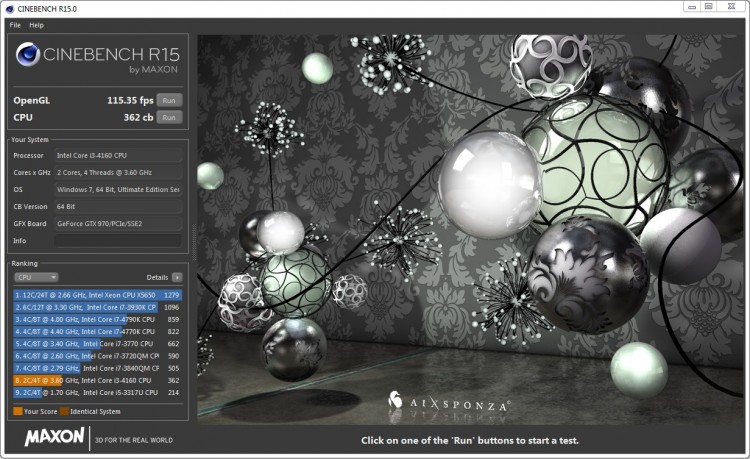
ASUS RealBench is a set of test applications that include: image editing, video encoding using the H264 codec, a test to evaluate the graphics subsystem and a multitasking test. Results are assessed depending on the time spent on a specific task.

The results are frankly modest, especially in comparison with the line Core processors i7.
Game testing
Testing methodology: all games were set to the maximum possible parameters, and VSync was disabled. The resolution at which testing was carried out was 2560x1440.
Assassin's Creed IV Black Flag - in general, even taking into account high resolution, is quite playable, especially if you slightly reduce the game’s graphical settings.


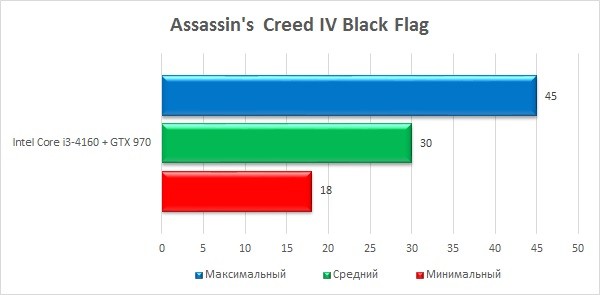
Crysis 3 still gives most games a run for their money and perfectly demonstrates the lack of system performance, but as we know, the video card plays the first role here.

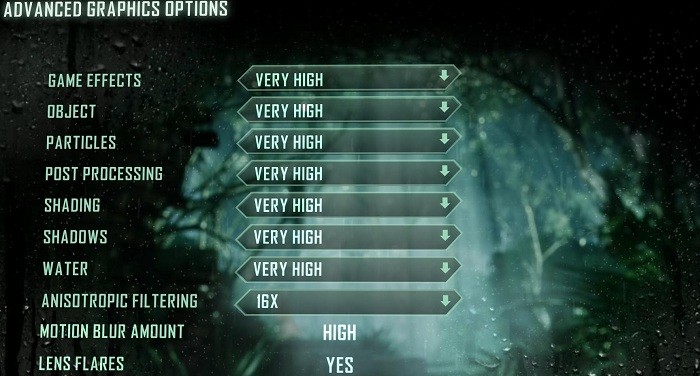

DiRT 3 shows excellent results in testing and even at 2560x1440 with ultra settings you can play without any problems.

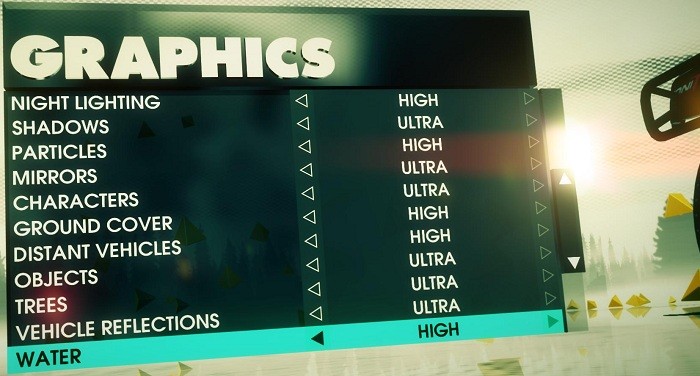

Far Cry 3 - the results are slightly better than in the case of Assassin's Creed IV Black Flag, i.e. you can play without any special difficulties.

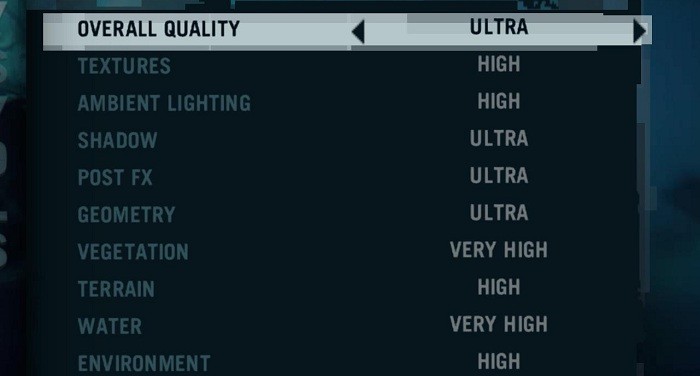

For Metro Last Light, such performance is clearly not enough; the graphics will have to be reduced.

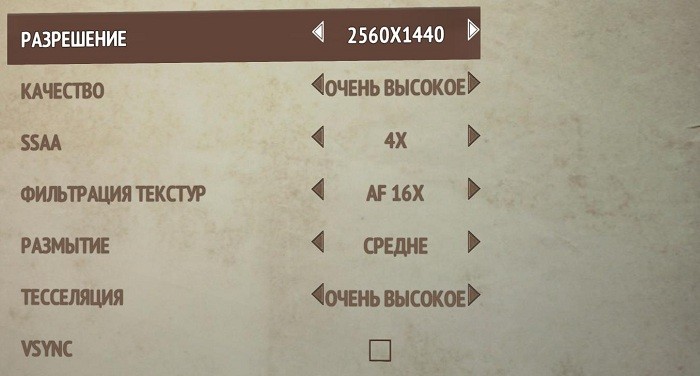
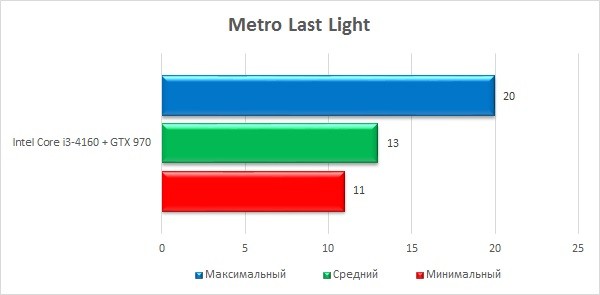
In the case of Tomb Raider and Thief 2014, built-in benchmarks were used to evaluate gaming performance. Despite some skepticism regarding the built-in tests, it can be argued that for the purity of the experiment, when several devices are compared, these tests look much more preferable. Tomb Raider is more demanding on your computer's gaming resources, so in this case you will have to lower the settings.




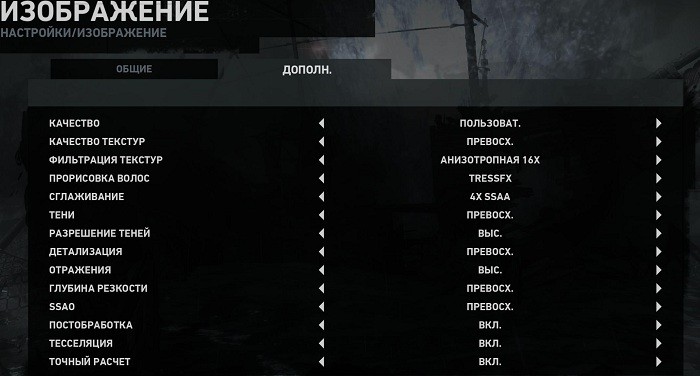

In general, I would like to note good level processor performance, especially in gaming applications. We can say with confidence that the Intel Core i3-4160 + GTX 970 combination looks quite harmonious and is more suitable for games than a Core i5/i7 with a weaker video card.
Conclusion
Intel Core i3-4160 is perfect as budget processor for the gaming platform, paired with a powerful video card, you can easily complete most games on maximum settings at FullHD resolution. In specialized multithreading-oriented tasks, you will also feel the difference compared to the younger Intel Pentium line.
Pros:
+
Good performance in games in tandem with a powerful video card
+
Low consumption and, as a result, reduced requirements for the cooler
+
Low operating temperature under load
+
Availability of built-in graphics core
Minuses:
-
No free multiplier
-
Lack of Turbo Boost support
Among gamers, recently there has been a wave of “believers in total multithreading” - modern games use all cores\N T-nuclei modern processors no matter how many there are, up to 16. Well, as they say, faith is a purely personal matter - who believes in Allah, who believes in the Immaculate Conception, who believes in ponies shitting rainbows, and who believes in total multi-threading. We will not be like these individuals, but will conduct a comparative analysis using the example of the game Battlefield 1.
But first, let’s look at what has changed in terms of the use of processors in modern gaming projects:
- full use of H
T-nuclei
Since 2016, game software developers have finally begun to use HT -processor cores i 3 and i 5 as full. And if earlier processors i 3 essentially worked like a “powerful” dual-core in games Pentium and overtook him only due to increased cache memory and more high frequency, then now i 3 can be considered a full-fledged 4x nuclear processor. By performance N T -cores are approximately equal to 50% of the standard, if compared figuratively with the processor i 5 then i 3 can be conditionally called a “three-core” in terms of performance;
- “understanding” of multi-core processors by program code
modern games “understand” that the processor has more than 2 cores and can distribute the flow program code depending on the load on the core.
So let's continue. In order not to be unfounded, we use data (coinciding with tests conducted in person) from the following article from the site overclockers.ru. The full article can be found here:
We will analyze the “Summary diagram of processor tests” given in this article. For convenience, it is included here separately. The part where various models processors are overclocked and operate at approximately the same frequency.
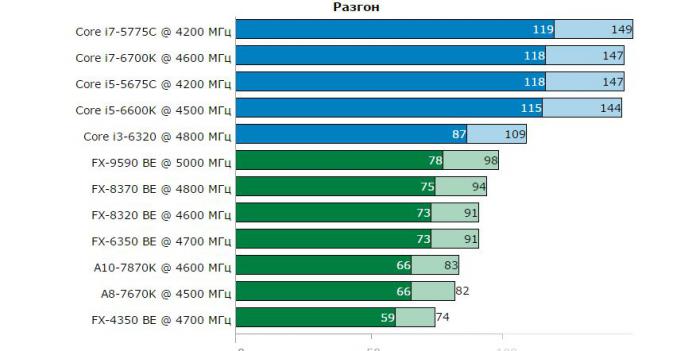
First, let's look at the speed of processors
AMD.
As can be seen from the table, low-end 4-core processors FX -4350 give half the performance of 4-core ones i 5. This is quite natural, since the kernels FX less productive than i 5. But the question arises - why then 8-core processors? FX-83 xx series is only 15-20% better in performance than 4 cores - because, logically, 8 cores should give performance 2 times greater than 4. To find the answer, consider 2 processor tests posted by users on the channel youtube.com
-
As we can see from this test, the game code “correctly” understands the processors of the series FX – all 4 processor cores FX -4350 is fully 100% loaded, the game runs in 4 threads.
And in this test, 8 processor cores are constantly used ONLY 50-60%. That is, in essence, we have in total the same 4 code streams that the processor driver evenly distributes across the physical cores. If the game could work in 8-threaded mode, then the cores would be loaded at 100% and the processors FX-83 xx in Battle they worked at the processor level i 5.
Now let's look at the speed of processors
Intel.
Everything is clearly clear here without any reasoning - processors i 5 and i 7 work exactly the same in the game - an increase from HT ZERO cores. Which once again proves that the game works EXACTLY IN 4 STREAM. This is presented even more clearly in this video:
What we see - all the nuclei i 5 work 100%, i 7 – the game code is being transferred again to distribute it evenly across all cores, but not a single core is 100% loaded - we have the same 4 threads. Here you can see the processor FX who has the same “trouble” as i 7 – not a single core is loaded at 100%.
Conclusion #1:
Although modern software understands multi-core processors The game code is still written for a maximum of 4 threads.
Why is this happening?
And the answer is given to us by the statistics of gaming hardware in Steam . At the time of writing, the OVERWHELMING majority of computers, according to its data, have 2 (47%) or 4 (47%) physical cores. Considering the statistics on AMD processors and INTEL among players (20% and 80%) and taking into account the fact that processors Pentium they are practically not installed in gaming machines - then we can say that a good half of the players at home have a processor i 3 (2 cores + 2 HT -nuclei). The remaining half either i 5 i 7 or something 4-core from AMD, but considering the cost i 7 – in reality there are less than half of them in this group (I think even less, 10 percent). It turns out that 70-80% (the vast majority) of players have this moment quad-thread or quad-core processors. Based on this information, it immediately becomes clear why “game makers” use optimization for 4 threads in their games - this allows their programs to work well on the vast majority of gaming machines.
Conclusion No. 2:
Until the trend in gaming hardware available to players changes, games will continue to be optimized specifically for 4 threads. Does it make sense to buy a processor from
Intelwith the number of cores\N
T-more than 4 cores? Yes, there is, but only when other programs are used in parallel with the gameplay or when financial resources are unlimited. Is this optimal - definitely NO - optimal or “fast”
i
3 or
i
5
. Is it optimal to use processors from older series?
FX,
PhenomfromAMDfor games - definitely not, series
Phenomtechnically outdated (no support
SSE4.2 – games simply won’t launch without them), and
FX(6-8 cores) – well suited for small servers, workstations for special needs. software that understands ALL processor cores, but definitely not for games.
